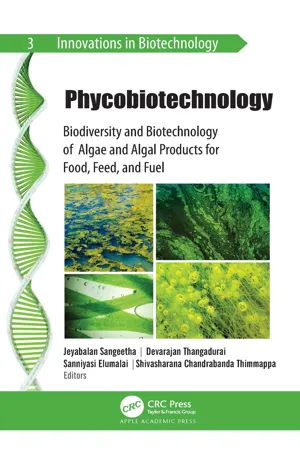Marine habitats play a very significant role in the ecological, productive habitat, biodiversity, and economical stability of the country. It has an exclusive economic zone (EEZ) of around 2.5 million sq. km., and accounts for about 8% of the global biodiversity (Oza, 2005). Generally, seaweeds are macroscopic and multicellular. Based on their pigmentation (chemical) present, macroalgae are classified into three main groups, viz., Rhodophyta, Phaeophyta, and Chlorophyta (Noel and Sekwon, 2013; Sahayaraj, 2015). Seaweeds have been used as human food from 600 to 800 BC in China and other countries in Asia (Plouguerne et al., 2014; Anand et al., 2016). China and Japan are the two major seaweed harvesting countries, where more than 70 species of seaweeds are consumed as salads directly or after cooking. Seaweeds play a vital role in marine food chains, food sources to humans, especially in East Asia (Japan), the Indo-Pacific (China, Indonesia), and the Pacific (Hawaii). It is recommended that seaweeds could become a foremost food and vigor resource in the 21st century. Presently, there are 42 countries in the world with reports of commercial exploitation of seaweeds. Among them, China holds the first rank, followed by North Korea, South Korea, Japan, Philippines, Chile, Norway, Indonesia, USA, and India. These top 10 countries contribute up to 95% of the world’s commercial seaweed utilization (Khan and Satam, 2003).
Nowadays, varieties of health care products like lotions, bath gels, shampoos, soaps, creams, and pharmaceutical components are being produced from the seaweeds. Braune and Guiry (2011) reported that a total of about 400,000 tonnes of seaweeds such as Porphyra (Nori), Laminaria (Kombu), and Undaria (Wakame) are harvested annually throughout the world. About 20,000 species of seaweeds are distributed throughout the world, of which 221 are commercially utilized, which includes 145 species for food and 110 species for phycocolloid production (Chennubhotla et al., 2013a,b). In India, the marine macroalgae include 217 genera, a total of 844 species of seaweeds (Saxena, 2012). The economic utility of seaweeds exposes that there are only very scanty and sporadic works have been carried out in various maritime states of India: Andhra Pradesh (Umamaheswara Rao, 1970, 2011; Anonymous, 1995); Andaman and Nicobar Islands (Jagtap, 1985, 1992; Gopinathan and Panigrahi, 1983; Rao and Rao, 1999; Palanisamy, 2012; Karthick et al., 2013); Gujarat (Thivy, 1958, 1982; Jha et al., 2009); Goa (Dhargalkar, 1981), Lakshadweep (Kaliaperumal et al., 1989; Koya et al., 1999; Koya, 2000; Kaladharan, 2001; Kumar and Kaladharan, 2007); Maharashtra (Dhargalkar et al., 1980); Odisha (Sahoo et al., 2001, 2003) and Tamil Nadu (Chennubhotla, 1977, 1996; Chennubhotla et al., 1981, 1987, 1988; Kaliaperumal et al., 1990, 1992, 1995, 2004). Seaweeds along the southeast coast of Tamil Nadu from Mandapam to Kanyakumari, Gujarat coast, Lakshadweep Island, and Andaman and Nicobar Islands having a luxuriant growth. Whereas abundant seaweeds are present in the locality of Bombay, Raighad, Ratnagiri, Sindhudurgh, Goa, Karwar, Varkala, Kovalam, Vizhinjam, Visakhapatnam, and few other places such as Chilka and Pulicat lakes.
1.2 TAXONOMY OF SEAWEEDS IN INDIA
India, the subcontinent (08°4’ to 37°6’ N and 68°7’ to 97°25’ E) is having a coastline of more than 7516 km and 1256 islands including Andaman, Nicobar, and Lakshadweep. The coastline of India is composed of littoral and sublittoral rocky areas of different seaweeds (agarophytes, alginophytes, and other edible seaweeds). The Indian coast is divided into the east coast and the West Coast. The West Coast is usually exposed with heavy surf, rocky shores, and headlands while the east coast is generally shelving with beaches, lagoons, delta, and marshes. Important Gulfs on the West Coast of India are the Arabian Sea, the Gulf of Kutch, and Gulf of Cambay, while the Arabian Sea washes the shores of Gujarat, Maharashtra, Goa, Karnataka, and Kerala maritime states. Besides the mainland, the Andaman and Nicobar Islands i...
